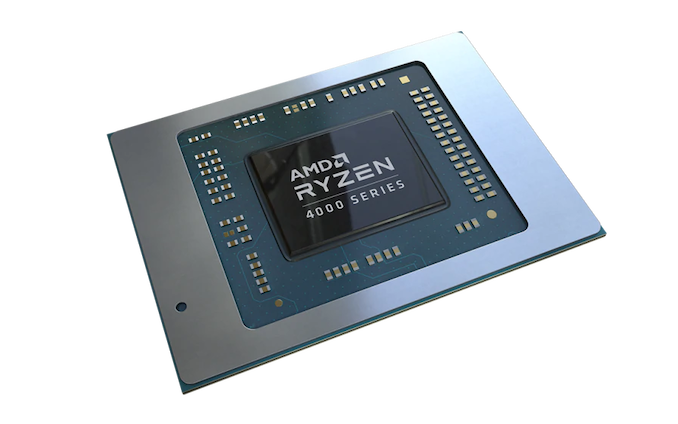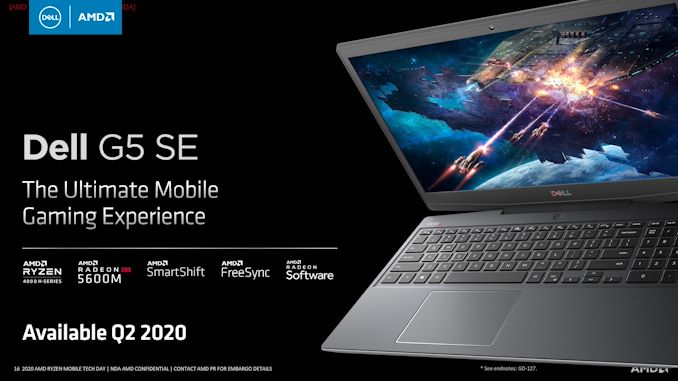AMD Confirms That SmartShift Tech Only Shipping in One Laptop For 2020
by Ryan Smith on June 5, 2020 5:00 PM EST
Launched earlier this year, AMD’s Ryzen 4000 “Renoir” APUs brought several new features and technologies to the table for AMD. Along with numerous changes to improve the APU’s power efficiency and reduce overall idle power usage, AMD also added an interesting TDP management feature that they call SmartShift. Designed for use in systems containing both an AMD APU and an AMD discrete GPU, SmartShift allows for the TDP budgets of the two processors to be shared and dynamically reallocated, depending on the needs of the workload.
As SmartShift is a platform-level feature that relies upon several aspects of a system, from processor choice to the layout of the cooling system, it is a feature that OEMs have to specifically plan for and build into their designs. Meaning that even if a laptop uses all AMD processors, it doesn’t guarantee that the laptop has the means to support SmartShift. As a result, only a single laptop has been released so far with SmartShift support, and that’s Dell’s G5 15 SE gaming laptop.
Now, as it turns out, Dell’s laptop will be the only laptop released this year with SmartShift support.
In a comment posted on Twitter and relating to an interview given to PCWorld’s The Full Nerd podcast, AMD’s Chief Architect of Gaming Solutions (and Dell alumni) Frank Azor has confirmed that the G5 15 SE is the only laptop set to be released this year with SmartShift support. According to the gaming frontman, the roughly year-long development cycle for laptops combined with SmartShift’s technical requirements meant that vendors needed to plan for SmartShift support early-on. And Dell, in turn, ended up being the first OEM to jump on the technology, leading to them being the first laptop vendor to release a SmartShift-enabled laptop.
It's a brand new technology and to @dell credit they jumped on it first. I explained reasons why during my interview with @pcworld @Gordonung @BradChacos No more SmartShift laptops are coming this year but the team is working hard on having more options ASAP for 2021.
— Frank Azor (@AzorFrank) June 4, 2020
Azor’s comment further goes on to confirm that AMD is working to get more SmartShift-enabled laptops on the market in 2021; there just won’t be any additional laptops this year. Which leaves us in an interesting situation where, Dell, normally one of AMD's more elusive partners, has what's essentially a de facto exclusive on the tech for 2020.
Source: Twitter












54 Comments
View All Comments
CiccioB - Monday, June 8, 2020 - link
Can't see what these tests should prove.I see low performance results with a not so good autonomy.
What should I look exactly to see that Picasso is a good efficient piece of silicon?
Drake H. - Saturday, June 6, 2020 - link
https://www.youtube.com/watch?v=xfIfN2kOaT0Sounds pretty decent to me. The consumption depends on the optimization of each manufacturer, it is remarkable that there is a wide variation in consumption, performance and battery life depending on the model analyzed, Xiaomi and Huawei have shown this well.
Spunjji - Monday, June 8, 2020 - link
That's still competitive when the cost is accordingly lower.I don't understand why some people seem to think something is only competitive if it's the same or better. There's a lot more to it than that.
Lord of the Bored - Saturday, June 6, 2020 - link
"For most people the extra $10 they will save in a year would be totally unnoticeable and it doesn't help that you can't explain what this does simply with a single sentence."Lemme try.
"It makes your games go faster and keeps your laptop cooler."
Spunjji - Monday, June 8, 2020 - link
He seems to think it's about saving power, which means he didn't even read the article (or any of the others on this topic) before commenting.1_rick - Friday, June 5, 2020 - link
The idea that [all] Renoir laptops ship with "worst hardware components" is ridiculous, too; the Zephyrus G14 is an obvious counterexample, as, apparently, is the Dell G5 this very article is about.Spunjji - Monday, June 8, 2020 - link
The Dell G5 proves his point. It's available with a more limited range of customizations than the Intel variants, and more specifically there are fewer high-end display options.The Zephyrus G14 is the only exception to the rule.
yeeeeman - Saturday, June 6, 2020 - link
I don't see why you say oems do not want to built AMD laptops. If that is the case then why Asus didn't do it? They were the first one to release AMD laptops and they even have a deal with them for the hs parts. So why didn't they just took the time to bulit a laptop with the magical smartshit feature?Everyone is winning on the internet about AMD laptops but they don't understand how things work. Building a laptop is not like building a PC. You have a lot of requirements to meet and without the direct implication and professional support from the manufacturer the OEM cannot just take some components and strap them to a laptop case. The only blame here is on AMD because they don't have great community with OEMs, don't have enough field engineers to support many projects with many OEMs and they don't have an optimized flow for new laptop platforms. They just can't compare with how Intel does this. I'd you would have access to the Intel technical library you'll see they give clear and periodic instructions and have detailed documents for oems. They have a lot of field engineers that support oems and they take care of oem requests, be it hardware or software. These things are missing from AMD and no matter how much you like AMD now and hate Intel (don't know why) Intel has worked a lot during the last 10 years to improve the laptops and thin and light laptops are more or less here thanks to apple and Intel.
So oems are used to expecting some type of support and professionalism that AMD simply doesn't have yet. So that is why oems don't have lots of AMD laptops. Also, when the existing laptops have been designed and was on Zen 1 which wasn't the greatest mobile performer.
CiccioB - Monday, June 8, 2020 - link
[blockquote]I don't see why you say oems do not want to built AMD laptops.[/blockquote]Not correct.
The right assertion is:
I don't see why you say oems do not want to built AMD laptops with AMD dGPU
which is the HW configuration where this Smartshift works.
Alistair - Friday, June 5, 2020 - link
nothing to do with not ready, the market wants nvidia GPUs, so you won't see it, as it needs the AMD gpu, and AMD's mobile GPU options are not great